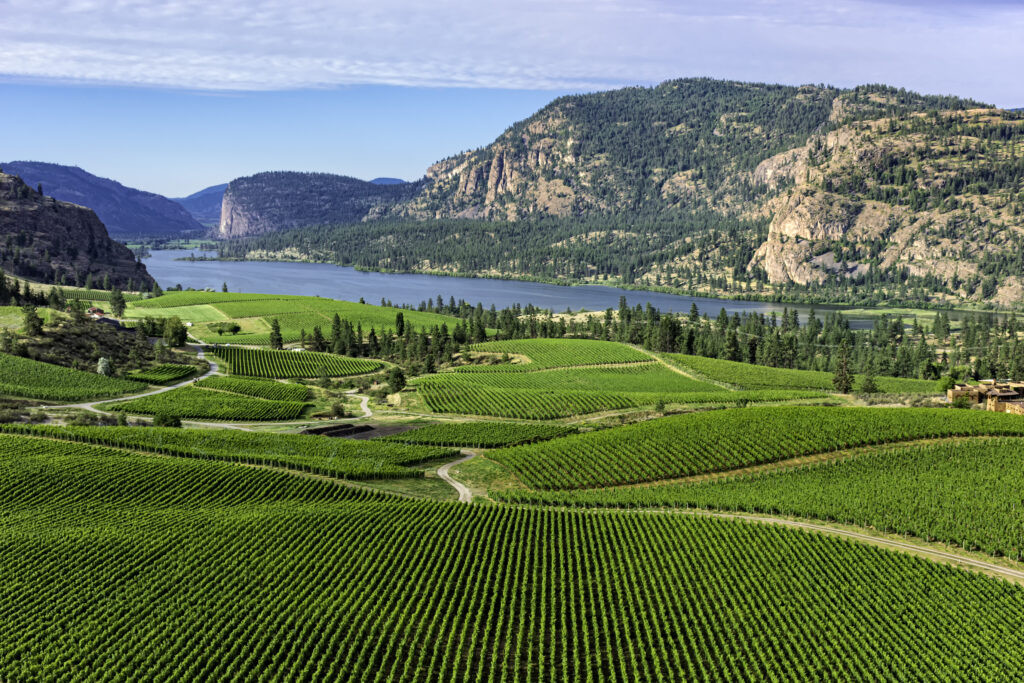Geography, climate and weather top the list of most influential factors when deciding where to plant a vineyard. In the Pacific Northwest, a vast expanse that covers Washington, Oregon, Idaho and the Canadian province of British Columbia, there is a diversity of natural factors that allows for a broad range of grapes and wine.
Wine-grape vineyards were planted in Washington in the late 19th century, around Walla Walla and the Yakima Valley. During the same period, international varieties were introduced to Idaho and Oregon, but it wasn't until the 1960s when Pinot Noir was planted in the Willamette Valley. During the same period, native North American grapes were replaced by vinifera, in the Okanagan Valley of British Columbia.
Overall growth in planted vineyards in the PNW was gradual. In terms of wineries, Washington led the way, until a few years ago, when Oregon, moved into first place with 1,116 wineries, compared to 1,050 for Washington. British Columbia has a total of 338 wineries, most of them in the Okanagan Valley. And, there are 65 wineries in Idaho.
 |
| Chateau Ste Michelle |
Washington
Washington is known best for its red wine, although the start of the wine industry was in another direction. In the late 19th century, European immigrants began planting wine-grape vineyards around Walla Walla. In time, there was a mix of vinifera, hybrids and labrusca varieties like Concord. Washington also went through a period of sweet dessert wine.
Today, more than 80 varieties are grown, mainly in the Columbia Valley, with Cabernet Sauvignon accounting for 28% of the total.
The foundation of American wine making was historically based on a French model. But, when planning wine estates, French vintners did not consider geography, since vineyards were planted next to or close to the winery.
That model didn't work in Washington, because the state's vineyards are mostly in the warmer eastern Columbia Valley, while many of the wineries are across the Cascade Mountains, in western Washington. Economics and open land are the main reasons for the separation.
In Bordeaux, vintners found the best place to grow Cabernet Sauvignon, then built a chateau-winery, next to the vineyard. Transportation for moving the wine to distant markets was convenient to the wine region. In Washington, the major transportation hub is in Seattle, across the mountains and many miles from the Columbia Valley.
Washington wineries are grouped northeast of Seattle, in Woodinville, home of Ch. Ste. Michelle, the state's best known winery. Walla Walla, a growing area in the southeast part of the state, includes the Rocks District of Milton-Freewater, located across the state line in Oregon. Washington is the second largest wine producing state, after California.
Oregon
For years, Oregon winemakers felt the pressure of being squeezed by California, its dominant neighbor to the south and the rapidly growing presence of Washington, Oregon's northern neighbor. And to make matters more difficult, Oregon wine was being portrayed as a "one trick pony."
Pressure aside, there was a solution on the horizon. In 1965, Oregon wine pioneer, David Lett, led an exodus from California to Oregon's Willamette Valley, where they found the area ripe for Pinot Noir. Lett helped build a nationwide reputation for Oregon Pinot Noir, and for that he became known as "Papa Pinot."
Oregon Pinot became so admired that provincial Burgundian winemaker, Robert Drouhin, found Willamette to be the singular place to establish his name, outside Burgundy.
Oregon white wine was more difficult to pin down. Chardonnay, Pinot Noir's white partner, had middling success at first in the Willamette, as some winemakers believed the terroir there better suited to Pinot Gris and Pinot Blanc. As it turns out, the three whites worked out and are today the valley's leading white wines, with Riesling not far behind.
Southern Oregon is home to two major wine areas: Umpqua Valley AVA and Rogue Valley AVA. Warmer conditions in the Rogue River Valley are better suited to Bordeaux varieties like Cabernet Sauvignon, Merlot and Cabernet Franc. Umpqua Valley, between the cooler Willamette and warmer Rogue Valley, is a good place for a wide range of wines, including those from Bordeaux varieties and popular Spanish grapes Albarino and Tempranillo.
 |
| The Okanagan Valley |
British Columbia
There are multiple wine areas in BC, all of them small, except for the Okanagan Valley, about 250 miles east of Vancouver. Grapes were first planted in the Okanagan in the mid-18th century by a French priest, for sacramental wines. In 1927, Vitis labrusca was tried, then 30 years later, it was hybrids. Finally, in the late 1970s, vinifera varieties overcame winter-kill problems, becoming the backbone of BC wine.
More than 100 wineries line the shores of Lake Okanagan or are a short distance from the water. The lake's tempering influence allows for Merlot, Cabernet Franc, Syrah, Chardonnay, Pinot Noir, Pinot Gris and Cabernet Sauvignon.
Idaho
The Snake River Valley, in southwestern Idaho is considered a high desert, yet it is home to more than 50 wineries that specialize in Bordeaux and Rhone varieties. An unusual feature of Idaho's viticulture is a small western part of the Snake River AVA juts into Oregon. Some of Idaho's wineries are located in the northern part of the state, just across the state line with Washington. Ste. Chapelle is Idaho's largest winery and Fraser Winery the oldest.
One way to off set the dominance of a neighbor, is to establish a recognizable niche in the market. Pacific Northwest wines have established local identity and are moving ahead.
Update: Last week's post on Sicilian White Wine got the attention of Jeff Hinchliffe, winemaker for Hanna Winery, in Sonoma's Dry Creek Valley. Hanna has planted California's first plot of Grillo, the Sicilian white grape, and Hinchcliffe plans Hanna's first Grillo in 2025. Hanna will also add the red Nero d'Avola.
Next post: The Douro
Leave a comment at boydvino707@gmail.com



No comments:
Post a Comment
Note: Only a member of this blog may post a comment.